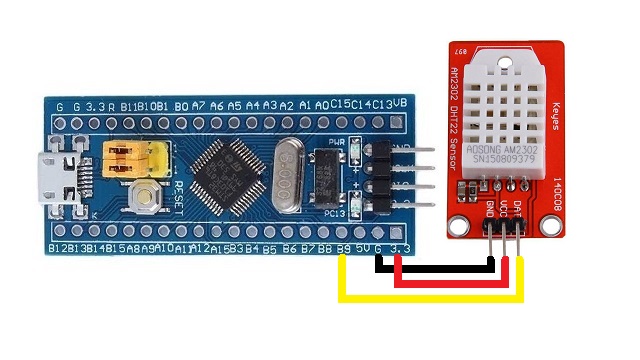Docs
Micro-controllers, wireless transmission and database

DHT22 Humidity & Temperature Sensor with Blue Pill using STM32CubeIDE
Prerequisites
This project assumes you have already installed STM32CubeIDE. You need to have previously done a basic blink sketch with blue-pill using STM32CubeIDE. I have made a complete video from installing STM32CubeIDE to LED blink program. You can watch it by clicking this link. https://www.youtube.com/watch?v=kXg467nVd_A
Datasheet
https://cdn-shop.adafruit.com/datasheets/Digital+humidity+and+temperature+sensor+AM2302.pdfWiring Diagram

STM32CubeIDE Settings
Click RCC → High Speed Clock (HSE) to Crystal/Ceramic Resonator
Click Clock Configuration tab → HCLK (MHz) to 72
Click Pinout and Configuration tab
Click Timer → Click TIM1 →
Clock Source set to Internal Clock
Configuration → Parameter Settings →
Prescaler set to 71
Set PB9 GPIO_Output
Additional code on top of STM32CubeIDE generated code
/* USER CODE BEGIN 0 */ #define DHT22_PORT GPIOB #define DHT22_PIN GPIO_PIN_9 uint8_t RH1, RH2, TC1, TC2, SUM, CHECK; uint32_t pMillis, cMillis; float tCelsius = 0; float tFahrenheit = 0; float RH = 0; void microDelay (uint16_t delay) { __HAL_TIM_SET_COUNTER(&htim1, 0); while (__HAL_TIM_GET_COUNTER(&htim1) < delay); } uint8_t DHT22_Start (void) { uint8_t Response = 0; GPIO_InitTypeDef GPIO_InitStructPrivate = {0}; GPIO_InitStructPrivate.Pin = DHT22_PIN; GPIO_InitStructPrivate.Mode = GPIO_MODE_OUTPUT_PP; GPIO_InitStructPrivate.Speed = GPIO_SPEED_FREQ_LOW; GPIO_InitStructPrivate.Pull = GPIO_NOPULL; HAL_GPIO_Init(DHT22_PORT, &GPIO_InitStructPrivate); // set the pin as output HAL_GPIO_WritePin (DHT22_PORT, DHT22_PIN, 0); // pull the pin low microDelay (1300); // wait for 1300us HAL_GPIO_WritePin (DHT22_PORT, DHT22_PIN, 1); // pull the pin high microDelay (30); // wait for 30us GPIO_InitStructPrivate.Mode = GPIO_MODE_INPUT; GPIO_InitStructPrivate.Pull = GPIO_PULLUP; HAL_GPIO_Init(DHT22_PORT, &GPIO_InitStructPrivate); // set the pin as input microDelay (40); if (!(HAL_GPIO_ReadPin (DHT22_PORT, DHT22_PIN))) { microDelay (80); if ((HAL_GPIO_ReadPin (DHT22_PORT, DHT22_PIN))) Response = 1; } pMillis = HAL_GetTick(); cMillis = HAL_GetTick(); while ((HAL_GPIO_ReadPin (DHT22_PORT, DHT22_PIN)) && pMillis + 2 > cMillis) { cMillis = HAL_GetTick(); } return Response; } uint8_t DHT22_Read (void) { uint8_t a,b; for (a=0;a<8;a++) { pMillis = HAL_GetTick(); cMillis = HAL_GetTick(); while (!(HAL_GPIO_ReadPin (DHT22_PORT, DHT22_PIN)) && pMillis + 2 > cMillis) { // wait for the pin to go high cMillis = HAL_GetTick(); } microDelay (40); // wait for 40 us if (!(HAL_GPIO_ReadPin (DHT22_PORT, DHT22_PIN))) // if the pin is low b&= ~(1<<(7-a)); else b|= (1<<(7-a)); pMillis = HAL_GetTick(); cMillis = HAL_GetTick(); while ((HAL_GPIO_ReadPin (DHT22_PORT, DHT22_PIN)) && pMillis + 2 > cMillis) { // wait for the pin to go low cMillis = HAL_GetTick(); } } return b; } /* USER CODE END 0 */ /* USER CODE BEGIN 2 */ HAL_TIM_Base_Start(&htim1); /* USER CODE END 2 */ /* Infinite loop */ /* USER CODE BEGIN WHILE */ while (1) { if(DHT22_Start()) { RH1 = DHT22_Read(); // First 8bits of humidity RH2 = DHT22_Read(); // Second 8bits of Relative humidity TC1 = DHT22_Read(); // First 8bits of Celsius TC2 = DHT22_Read(); // Second 8bits of Celsius SUM = DHT22_Read(); // Check sum CHECK = RH1 + RH2 + TC1 + TC2; if (CHECK == SUM) { if (TC1>127) // If TC1=10000000, negative temperature { tCelsius = (float)TC2/10*(-1); } else { tCelsius = (float)((TC1<<8)|TC2)/10; } tFahrenheit = tCelsius * 9/5 + 32; RH = (float) ((RH1<<8)|RH2)/10; } } HAL_Delay(1000); /* USER CODE END WHILE */ /* USER CODE BEGIN 3 */ } /* USER CODE END 3 */